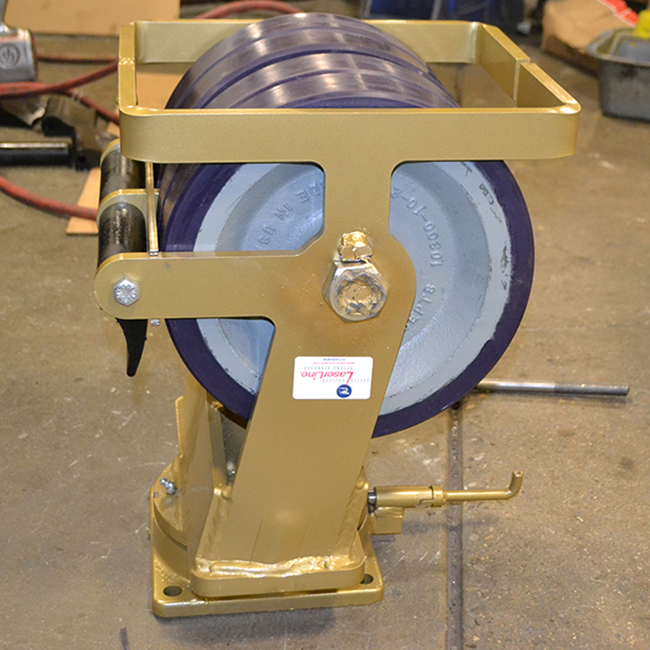

In caster applications involving swivel locks, straight line motion is often required while high maneuverability is required in other aspects of the application. This makes the ability to lock/unlock the swivel casters to and from a rigid state very desirable. Swivel locks are often the answer for this, and come in a variety of designs. The swivel lock can be a permanent add-on to the caster, welded in place to take up less space.
The standard swivel lock uses a spring/plunger design to engage a pin into a notch. Usually the notches are located on the lower half of the caster swivel section, are in four places at 90° intervals, and are parallel and perpendicular to the caster legs. The spring and plunger are housed in a barrel which is welded onto the caster top plate. The spring plunger is then activated by pulling on a handle or pull-ring and rotating the plunger to engage into a notch pattern on the swivel lock barrel. There are usually two notch patterns, one that allows the plunger to engage the notches on the swivel section and another to disengage the swivel lock.
The demountable swivel lock works the same as the standard swivel lock except the barrel is not welded onto the caster top plate. The barrel is welded onto a separate plate which has the same mounting pattern as the caster top plate. Then the mounting bolts are used to secure the demountable swivel lock to the caster. This design allows the user to remove the swivel lock completely or add one at a later date to their industrial casters.
Swivel locks can also be designed to have a passive affect, where the lock keeps the caster locked in one position until a side load is applied and the caster begins to swivel freely again. This lock is permanently engaged and uses a plunger with a round tip and swivel section notches that are round to reduce the amount of force needed to disengage the swivel lock. These locks do not require any manual locking/unlocking and are good for applications where straight line manual motion is required before the cart is turned with a powered tugger or forklift. The plunger can also be made to be adjustable to allow the end used to change the amount of force needed to disengage the swivel lock.
Another type of swivel lock is the vertical swivel lock. This lock is different because it mounts perpendicular to the direction of motion and usually threads into the bottom half of the caster swivel section. The plunger then engages into holes drilled into the top half of the caster swivel section. This type of swivel lock is used in heavy duty applications because the complete engagement of the pin into a hole makes for a stronger swivel lock that can handle much larger side loads without yielding.
Swivel locks can be a very useful option to your industrial caster application. They allow the user to change swivel to rigid, when straight line motion is needed, and back to swivel when maneuverability is needed. There are a wide variety of swivel lock designs and specifying the correct design can make the difference in an application. Consult with the engineering staff at Caster Concepts, Inc. when facing applications where low maintenance and high performance swivel locks may be helpful.